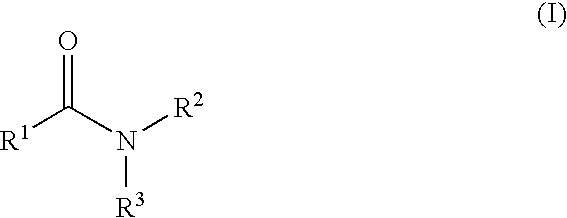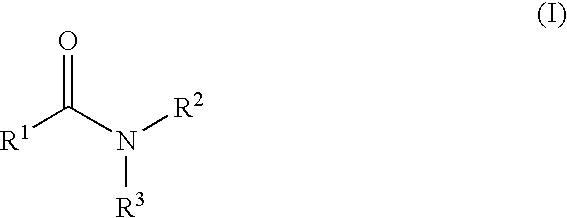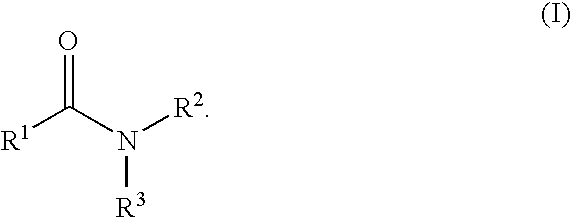Aromatic amides and ureas and their uses as sweet and/or umami flavor modifiers, tastants and taste enhancers
a technology of aromatic amides and ureas, which is applied in the field of flavor or taste modifiers to achieve the effects of enhancing, modulating or inducing other natural and synthetic savory flavoring agents, and enhancing the response in vitro
- Summary
- Abstract
- Description
- Claims
- Application Information
AI Technical Summary
Benefits of technology
Problems solved by technology
Method used
Image
Examples
example 1
N-(heptan-4-yl)benzo[d][1,3]dioxole-5-carboxamide
[0487]
[0488] To a solution of heptan-4-amine (8.06 mL, 54 mmol) in triethylamine (15.3 mL, 108 mmol) and dichloromethane (135 mL), was added, dropwise at 0° C., a solution of benzo[1,3]dioxole-5-carbonyl chloride (10 g, 54 mmol) dissolved in dichloromethane (135 mL). The reaction mixture was stirred for 1 h. Solvent was removed under reduced pressure and the residue was dissolved in EtOAc. The organic layer was washed successively with 1 N aq. HCl, 1 N aq. NaOH, water, brine, dried (MgSO4) and concentrated. The residue was recrystallized in EtOAc and Hexanes to afford 6.9 g of N-(heptan-4-yl)benzo[d][1,3]dioxole-5-carboxamide (48.3%) as a white solid. 1H NMR (500 MHz, CDCl3): δ 0.92 (t, 6H), 1.38 (m, 6H), 1.53 (m, 2H), 4.11 (m, 1H), 5.63 (m, 1H), 6.01 (s, 2H), 7.98 (d, 1H), 7.27 (s, d, 2H). MS (M+H, 264).
[0489] The compound had EC50 for activation of a hT1R1 / hT1R3 umami receptor expressed in an HEK293 cell line of 0.2 μM, and when p...
example 2
N-(2-methylheptan-4-yl)benzo[d][1,3]dioxole-5-carboxamide
[0490]
[0491] Prepared in a similar manner to example 1 using benzo[d][1,3]dioxole-5-carbonyl chloride and 2-methylheptan-4-amine (example 2a). 1H NMR (500 MHz, CDCl3): δ 0.93 (m, 9H); 1.38 (m, 5H); 1.53 (m, 1H); 1.66 (m, 1H); 4.21 (m, 1H); 5.61 (d, 1H); 6.01 (s, 2H); 6.82 (d, 1H); 7.26 (m, 2H). MS (278, M+H).
[0492] a. Preparation of 2-methylheptan-4-amine:
[0493] To a solution of 2-methylheptan-4-one (4.24 g, 33.07 mmol), in methanol (60 mL), were added ammonium acetate (25.50 g, 330.71 mmol) and sodium cyanoborohydride (2.08 g, 33.07 mmol). The reaction mixture was stirred at room temperature for about 24 hours. The solvent was removed under reduced pressure and the residue was diluted with water and basified with 15% NaOH aqueous and extracted with ether. The extract was washed with brine, dried over anhydrous magnesium sulfate, filtered and evaporated to give 3.3 g of 2-methylheptan-4-amine (77%). MS (M+H, 130).
[0494] Th...
example 3
N-(2-methylhexan-3-yl)benzo[d][1,3]dioxole-5-carboxamide
[0495]
[0496] Prepared in a similar manner to example 1 using benzo[d][1,3]dioxole-5-carbonyl chloride and 2-methylhexan-3-amine (example 3a). 1H NMR (500 MHz, CDCl3): δ 0.93 (m, 9H); 1.37 (m, 3H); 1.56 (m, 1H); 1.83 (m, 1H); 4.01 (m, 1H); 5.67 (d, 1H); 6.02 (s, 2H); 6.82 (d, 1H); 7.28 (m, 2H). MS (M+H, 264).
[0497] a. 2-methylhexan-3-amine was prepared using the same procedure described in example 2a starting from 2-methylhexan-3-one. Yield: 40%. 1H NMR (500 MHz, CDCl3): δ 0.86 (d, 3H); 0.91 (m, 6H); 1.20-1.29 (m, 2H); 1.38-1.47 (m, 2H); 1.47 (s, 2H); 1.58 (m, 1H); 2.51 (m, 1H). MS (M+H, 116).
[0498] The compound had EC50 for activation of a hT1R1 / hT1R3 umami receptor expressed in an HEK293 cell line of 0.61 μM.
PUM
 Login to View More
Login to View More Abstract
Description
Claims
Application Information
 Login to View More
Login to View More - R&D
- Intellectual Property
- Life Sciences
- Materials
- Tech Scout
- Unparalleled Data Quality
- Higher Quality Content
- 60% Fewer Hallucinations
Browse by: Latest US Patents, China's latest patents, Technical Efficacy Thesaurus, Application Domain, Technology Topic, Popular Technical Reports.
© 2025 PatSnap. All rights reserved.Legal|Privacy policy|Modern Slavery Act Transparency Statement|Sitemap|About US| Contact US: help@patsnap.com



